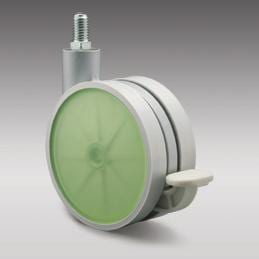 Two Main Types of Casters
Two Main Types of Casters
Although casters can come in many different designs, they can all be classified into two main types. Casters can be swivel or rigid. Of course, the two main types are self-explanatory as to how they behave. The swivel casters allow for a full range of circular movement of the caster wheel underneath the item. Rigid casters do not change direction at all.
Rigid casters are mounted to a stationary plate, which does not allow the caster to swivel. A rigid caster can be used on items that only need to move in straight lines. In these instances, a rigid caster can even be helpful in keeping the item on track. Rigid casters can also be used in conjunction with swivel casters to create a platform that can both be turned and steered in a straight line.
A swivel caster is used for items that need to move in more than one direction. Some familiar examples of items that use swivel casters are furniture or mechanic dolly. These items could be very hard to maneuver if rigid casters were used. By using 4 swivel casters a platform can be turned or rotated 360 degrees without any forward movement.
Casters Classified By Braking Ability
The most common brake on a caster locks the wheel and stops it from rotating. Tread lock, top lock, and side lock casters all positively break the wheel and stop it from traveling further. These brake casters are commonly used to prevent items from rolling or moving while unattended or left on an uneven surface or incline.
Some casters are classified as total lock brake casters. With these types of casters, the user is able to lock both the swivel abilities of the castor and the wheel movement. This can make the item completely stationary. This can be helpful when an item needs to have a full range of motion but also have the ability to be locked in place.
Other casters are classified as directional lock casters. With these types of casters, partial braking is available. The casters function as swivel casters until they are locked. Once they are locked the swivel movement is locked. This temporarily turns the swivel casters into rigid casters. This can be helpful in times when an item needs to have a full range of motion most of the time but be locked into straight-line motion temporarily.
Casters Classified By Amount of Weight Supported
Light duty casters can support up to about 145 pounds of weight. These types of casters are commonly used for computer or laundry equipment
Medium duty casters can support anywhere from 140 to around 325pounds of weight. They are commonly used in hospitals or for display racks.
Heavy-duty casters can support from 300 to about 3500 pounds. These types of casters are even used on trucks and transport trailers. Special versions of these casters can be ordered that will even support up to 44.000 pounds.
What Are the Pros and Cons of Different Caster Designs?
Different types of casters exist for different purposes. Each type of caster has pros and cons that make them better suited for certain purposes. Make sure to research and select the type of caster that meets the needs of the job.
If you want to find the absolute best caster design to fit your needs, contact Douglas Casters and Material Handling Equipment today. Let us help you find the perfect match.




